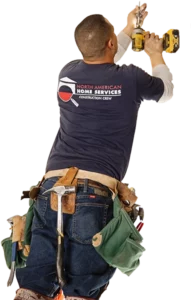If you’re searching for a new home, cost is likely at the forefront of your mind. You have to determine if the house you’re considering meets your wants, needs, and plans for the future, while also fitting within your budget.
While you might be well prepared to cover all the basic costs of purchasing a home—hiring a home inspector, closing costs, and buying new furnishing—you don’t want to be stuck with a hefty appliance repair or system replacement after you complete the sale and move in.
When you’re searching for a home, if you’re considering one that comes with existing appliances, it’s important to factor the age of appliances and home systems into your decision making, as older fixtures might be inefficient or beyond repair. Outdated appliances that no longer work can quickly balloon your initial budget, becoming very costly to deal with.
Depending on the material and general quality, some floors, doors, and countertops will never require replacing, whereas older appliances like dishwashers and stoves last only a handful of years.
For some home buyers, houses built in the first half of the 20th century are appealing because of their classic, traditional feel. These homes often have original wood floors, crown molding, and doors dating back to when they were first built, because such wood features were designed to last for the life of the home with proper care.
On the other hand, old appliances and home systems, such as stoves, dishwashers, laundry machines, and refrigerators, can be an issue. Not only will they likely appear worn due to extensive use, and outdated because interior styles have changed, there is a high likelihood that they won’t function properly, either.
Heating, ventilation, and air (HVAC) systems, as well as roofs, plumbing, and other home systems are critical features which can require costly repair or replacement.
According to the National Association of Home Builders, the life expectancy of a typical home appliance ranges from six to fifteen years, with heavy usage and style preferences the two main reasons that appliances are replaced. Meanwhile, HVAC systems are expected to last an average of twenty years, so long as regular maintenance is performed. Lastly, depending on the material, roofing lasts anywhere from twenty to fifty years.
You likely won’t have the ability to test existing appliances to determine if they are in proper working order prior to purchasing a home, though you can inquire with the home seller about the age and functionality of the systems. Beyond that, a telltale sign that an appliance requires or will soon require replacing is its appearance. Scratches, dents, missing buttons, and grime and dirt buildup are all evidence of an appliance that will need to be replaced soon.
While aging appliances can be a source of unpleasant surprises, HVAC systems, roofs, doors, floors, and plumbing are all assessed during a home inspection, so you’ll know if those systems need to be replaced or are in good working order.
If one or more kitchen appliances no longer work, replacement costs can exceed $5,000, while washing machines and dryers can cost upwards of $700 each.
Kitchen appliances generally receive extensive use. Because of this high usage, they require replacing every ten or so years. If you’re considering a home with old kitchen appliances, replacing or repairing them can be costly.
The average price of a dishwasher is between $400 and $700, with luxury dishwashers costing upwards of $1,000. New refrigerators cost from $400 to more than $2,000, depending on size, configuration and features. The same goes for gas and electric stoves. The typical price for a basic range is around $500, while top-of-the-line models sell for more than $2,000. Microwaves are one of the cheapest major kitchen appliances. You’ll be able to find one for less than $200.
If you’re looking at a home with an outdated washer and dryer that need to be replaced, a new machine’s cost depends on its configuration—whether it is top load or front load, and if it is stacked or not. You can pick up new top load washers and dryers for $600 to $700. On the other hand, front load machines are more expensive, costing an average of $300 more than top loaders. If you’re looking to maximize space, a stacked washer and dryer unit will cost more than $1,300.
If you opt to go with a repair instead of replacing the appliance, it’s important to consider the type of repair that needs to be done. If it’s something simple, like a door seal or new latch, then you can likely prolong the life of the appliance for less money than it costs to replace it. But if it requires a new motor or other major repair, then you’ll spend as much or more in parts and labor as you would buying a new machine.
Your home inspector will tell you what state the HVAC system, roof, and other major home systems are in, and recommend whether or not they should be replaced.
While home inspectors do run the dishwasher a full cycle to check for leaks and proper plumbing, they do not inspect other appliances like refrigerators or washing machines. Home inspectors thoroughly assess the home’s HVAC system, the structural integrity of the roof, plumbing, and more. After the inspection is completed, you will be given a detailed inspection report outlining what the inspector found. If there is an issue it will be listed in the report. This is where things can become a bit more complicated, as the seller might be responsible for paying for a replacement system.
Some home sellers purchase a home warranty prior to listing their home for sale. A home warranty works just like insurance: the seller pays a monthly premium to insure home appliances and home systems. If an appliance breaks, the home warranty covers the cost of replacement. If the seller does not have a home warranty, then check with them to find out if their regular homeowners insurance covers the cost of replacing home systems.
Sale contingencies might specify who is responsible for major system or infrastructure replacements. Contingencies are put in place prior to the home inspection. If the contract stipulates the home seller is fully responsible for home repairs, you won’t have to pay anything. It might also state that the seller and buyer share responsibility, so you might pay for half of the replacement cost.
If you agreed to purchase the home “as-is,” then you have no recourse to ask the seller to foot the bill. You can negotiate with them to reduce the sale price, but they don’t have to agree. You can always back out of the deal if you don’t want to pay for the replacements.
New HVAC systems are rather expensive, costing up to $9,000 for installation and associated labor. That price shoots up to $12,000 if ductwork is required. New roofing can be quite costly as well, with contractors charging more than $4.00 per square foot, depending on the material.
As you can see, outdated appliances and home systems are costly to replace. If you’re looking to buy a home, but are concerned about the age of appliances, talk with the seller to determine if they’ll need replacing soon—you might be able to negotiate a lower sale price. And you can always fall back on the inspection report to know if major home systems aren’t working properly. If you have any questions about home inspections, and what North American Home Services’ inspectors look for when they inspect a home, contact us today!




